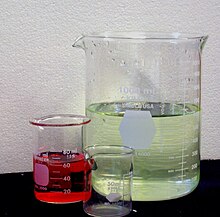 A beaker is a simple container for stirring, mixing and heating liquids commonly used in many laboratories. Beakers are generally cylindricalin shape, with a flat bottom. Most also have a small spout (or "beak") to aid pouring as shown in the picture. Beakers are available in a wide range of sizes, from one millilitre up to several litres.
A beaker is a simple container for stirring, mixing and heating liquids commonly used in many laboratories. Beakers are generally cylindricalin shape, with a flat bottom. Most also have a small spout (or "beak") to aid pouring as shown in the picture. Beakers are available in a wide range of sizes, from one millilitre up to several litres.Structure
Standard or "Low-form" beakers typically have a height about 1.4 times the diameter. The common low form with a spout was devised by John Joseph Griffin and is therefore sometimes called a Griffin beaker. These are the most universal character and are used for various purposes - from preparing solutions and decanting supernatant fluids to simple reactions.
"Tall-form" (B) beakers have a height about twice the diameter.These are sometimes called Berzelius beakers. They are mostly used for titration.
Flat beakers (C) are often called crystallizers, because most are used to perform crystallization, but often it is also used as a vessel for use in hot-bath heating. These beakers usually do not have a flat scale.
A beaker is distinguished from a flask by having sides which are straight rather than sloping. The exception to this definition is a slightly conical sided beaker called a Phillips beaker.
Materials
Beakers are commonly made of glass (today usually borosilicate glass), but can also be in metal (such as stainless steel or aluminium) or certain plastics (notably polythene, polypropylene, PTFE). A common use for polypropylene beakers is gamma spectral analysis of liquid and solid samples.
Shape
Beakers are often graduated, that is, marked on the side with lines indicating the volume contained. For instance, a 250 mL beaker might be marked with lines to indicate 50, 100, 150, 200, and 250 mL of volume. These marks are not intended for obtaining a precise measurement of volume (a graduated cylinder or a volumetric flask would be a more appropriate instrument for such a task), but rather an estimation.
The presence of a lip means that the beaker cannot have a lid. However, when in use, beakers may be covered by a watch glass to prevent contamination or loss of the contents, but allowing venting via the spout. Alternatively, a beaker may be covered with another larger beaker that has been inverted, though a watch glass is preferable.
source: wikipedia

No comments:
Post a Comment